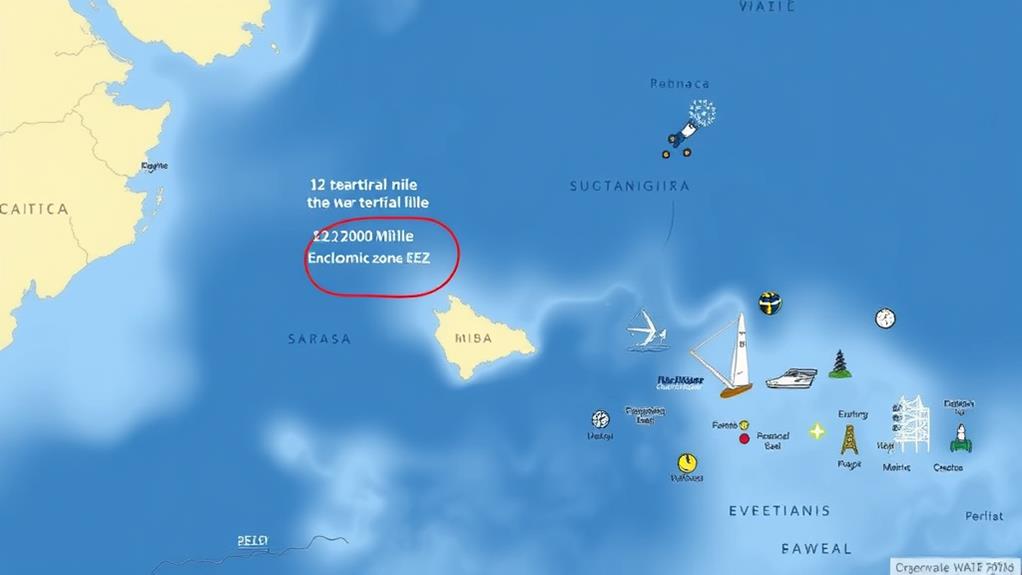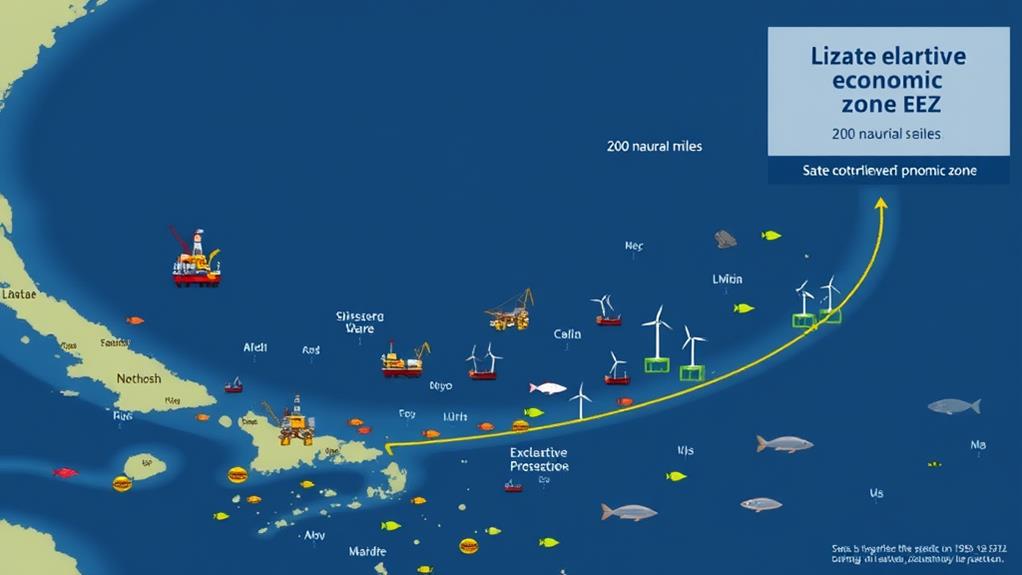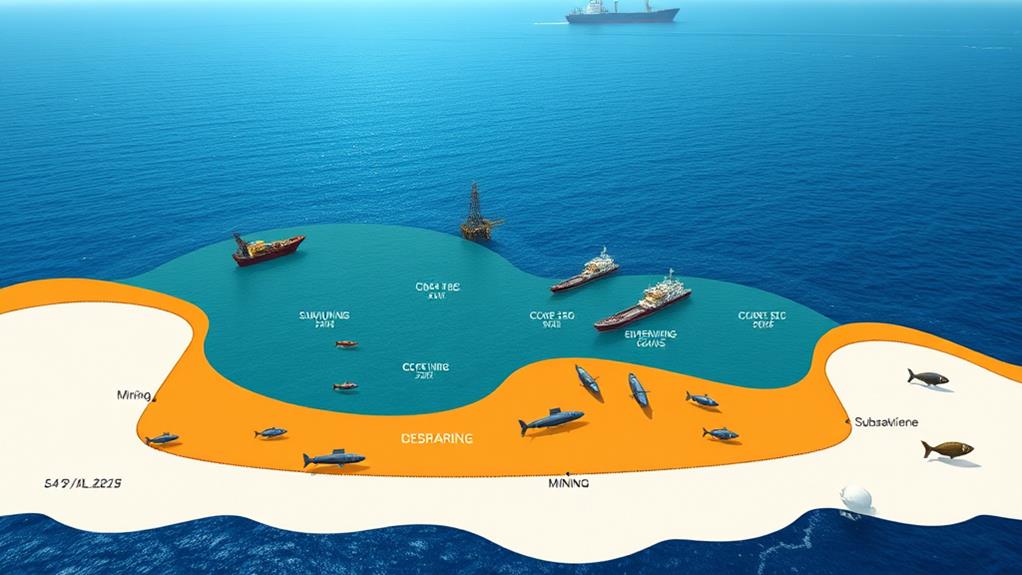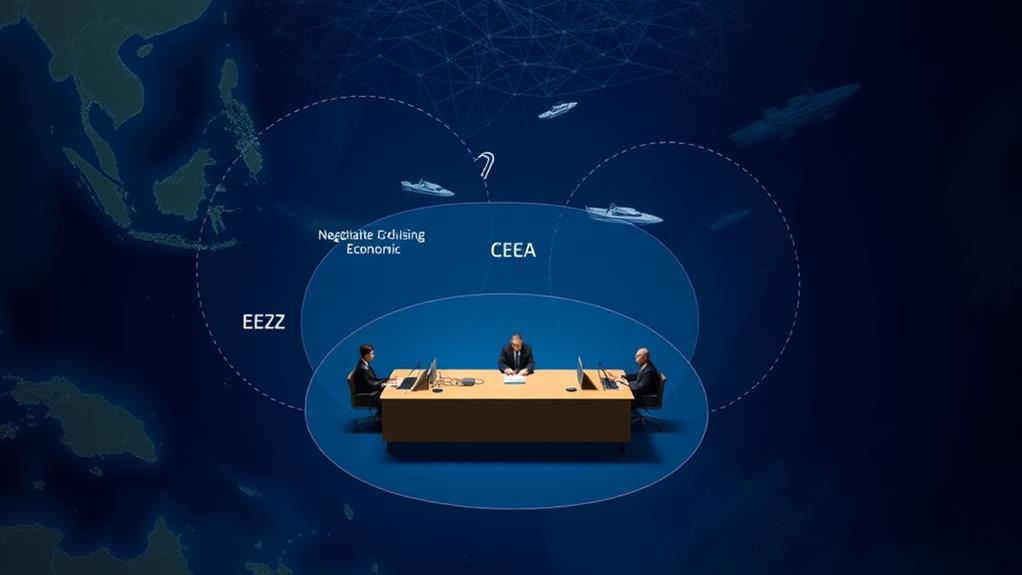The Exclusive Economic Zone (EEZ) extends up to 200 nautical miles from a country's coast. This zone is governed by the United Nations Convention on the Law of the Sea (UNCLOS).
Within this zone, a country has the right to explore and exploit both living and non-living marine resources, including jurisdiction over artificial islands and structures.
A country also has responsibilities to conserve and manage these resources sustainably. This means protecting the marine environment and preventing pollution.
For example, deep sea mining must comply with international standards to avoid harming the ecosystem.
Additionally, a country must ensure freedom of navigation and overflight while enforcing its coastal laws.
EEZ Definition and Scope

An exclusive economic zone (EEZ) is an area beyond and adjacent to a country's territorial sea, extending up to 200 nautical miles from the baselines from which the breadth of the territorial sea is measured.
This zone is subject to a specific legal regime established by the United Nations Convention on the Law of the Sea (UNCLOS), which governs the rights and jurisdiction of the coastal State and the rights and freedoms of other States.
The EEZ doesn't include the territorial sea, which extends up to 12 nautical miles from the coast, nor does it include the continental shelf beyond 200 nautical miles.
Within the EEZ, the coastal State has sovereign rights for exploring and exploiting natural resources, including living and non-living resources.
For example, the coastal State can explore and exploit fish, oil, and gas within its EEZ. The coastal State also has jurisdiction over the establishment and use of artificial islands, installations, and structures, as well as over marine scientific research and the protection and preservation of the marine environment.
The EEZ helps balance the rights of the coastal State with the freedoms of navigation and overflight enjoyed by other States.
This means that while the coastal State has control over its EEZ, other States are still allowed to navigate and fly over the area freely.
Historical Development of EEZs
The concept of the Exclusive Economic Zone (EEZ) emerged during the Third United Nations Conference on the Law of the Sea, held from 1973 to 1982. This conference marked a significant shift in international maritime law, as it established a new legal regime where coastal states could assert control over a broad area of waters beyond their territorial seas.
The importance of maritime routes underscores the need for countries to secure economic interests in their adjacent waters.
Prior to this, coastal states had limited jurisdiction, typically extending only 3 to 4 nautical miles from their shores.
The EEZ was a response to the growing recognition of the economic importance of marine resources.
Key milestones in the historical development of EEZs include:
Post-WWII Assertiveness: After World War II, coastal states began asserting greater rights and jurisdiction over seabed and water columns, driven by a belief in the abundance of natural resources beneath.
Continental Shelf Claims: Latin American and African states made claims to broad territorial seas and fishing zones, leading to the concept of a "patrimonial sea" of up to 200 nautical miles.
Kenya's EEZ Proposal: In 1971, Kenya introduced the concept of the EEZ to the Asian-African Legal Consultative Committee and the UN Sea-Bed Committee in 1972, which gained support from many developing states.
UNCLOS Codification: The United Nations Convention on the Law of the Sea (UNCLOS) in 1982 codified the EEZ, providing a legal framework that has been adopted by most coastal states worldwide.
These developments have transformed the way nations manage and exploit marine resources, giving them greater control over economic activities and resource extraction within their designated EEZs.
Rights of Coastal States

Rights of Coastal States in the Exclusive Economic Zone (EEZ)
In the Exclusive Economic Zone (EEZ), a coastal state has specific rights and responsibilities, as outlined in the 1982 United Nations Convention on the Law of the Sea (UNCLOS).
Key Rights of Coastal States
Exploration and Exploitation: A coastal state has sovereign rights to explore and exploit natural resources, including both living and non-living resources, such as fish, oil, and gas.
Conservation and Management: Coastal states are responsible for conserving and managing the living resources within their EEZ to ensure sustainable use. For example, they regulate fishing to prevent overfishing and protect endangered species.
Marine Environment Protection: States must protect and preserve the marine environment, including preventing pollution and protecting rare ecosystems, such as coral reefs.
These rights enable coastal states to regulate activities within their EEZ, including fishing, energy production, and deep-sea mining.
Additionally, they've jurisdiction over the establishment and use of artificial islands, installations, and structures.
Coastal states must also respect the rights and duties of other states, particularly in terms of navigation and overflight.
Management of Marine Resources
Managing Marine Resources
As a coastal state, you have the sovereign rights to explore, exploit, conserve, and manage the natural resources within your Exclusive Economic Zone (EEZ), both living and non-living, as outlined in the United Nations Convention on the Law of the Sea (UNCLOS).
Conservation and Management of Fisheries
You must determine and enforce fishing quotas to ensure the sustainable use of fish populations. This involves monitoring fish populations and implementing measures to prevent overfishing.
For example, setting catch limits for specific species can help maintain a healthy fish population.
Protection of Marine Environment
You are obligated to protect and preserve the marine environment, including preventing pollution and protecting rare or fragile ecosystems.
This can be achieved by implementing regulations on waste disposal, protecting coral reefs, and establishing marine protected areas.
Regulation of Research and Exploitation
You must regulate activities such as marine scientific research to ensure that it's conducted in a responsible and sustainable manner.
Additionally, you must regulate the exploitation of energy resources like wind and currents, ensuring that these activities don't harm the marine environment.
International Cooperation
You may need to enter into agreements with other states to manage shared resources and resolve potential conflicts.
This cooperation can help ensure the sustainable use of resources that cross national boundaries.
Environmental Protection Obligations

Coastal states have a critical responsibility to protect the marine environment within their Exclusive Economic Zone (EEZ).
As a coastal state, you must take measures to prevent, reduce, and control pollution from any source, as mandated by the United Nations Convention on the Law of the Sea (UNCLOS). This includes protecting rare or fragile ecosystems and the habitat of depleted, threatened, or endangered species and other forms of marine life.
Agusan Marsh's unique ecosystems, for instance, demonstrate the importance of preserving such habitats to maintain biodiversity.
Activities within your EEZ, such as deep sea mining, offshore energy production, and fishing, must be conducted in accordance with international standards. You must regulate and monitor these activities closely to prevent pollution and environmental degradation.
Additionally, you are required to share information about the populations of resources in your EEZ to promote international scientific cooperation and sustainable management practices.
Failure to comply with these environmental protection obligations can lead to significant ecological damage and potential disputes with other states. Therefore, it's crucial to implement and enforce stringent environmental regulations within your EEZ.
Freedom of Navigation and Overflight
Freedom of Navigation and Overflight in an Exclusive Economic Zone (EEZ)
Freedom of navigation and overflight within an EEZ is a critical aspect of international maritime law, governed by the United Nations Convention on the Law of the Sea (UNCLOS). This freedom isn't absolute and is subject to certain conditions and regulations.
Innocent Passage
You have the right to pass through an EEZ without engaging in activities that could harm the coastal state's interests. This means you can't conduct research or fishing without permission.
Laying Submarine Cables and Pipelines
The laying of international submarine cables and pipelines is allowed in an EEZ. However, it must comply with the coastal state's laws and regulations, ensuring no harm to the marine environment.
Overflight
Aircraft are permitted to fly over EEZs. They must adhere to international aviation laws and respect any restrictions imposed by the coastal state.
Compliance with Coastal State Laws
You must comply with the laws and regulations of the coastal state when navigating or overflying an EEZ. This ensures that your activities don't conflict with their rights and duties under UNCLOS.
These provisions strike a balance between the rights of coastal states to manage their resources and the need for unimpeded navigation and overflight, fostering international cooperation and maintaining the stability of maritime activities.
Regulation of Deep Sea Mining

Deep Sea Mining Regulations
Coastal State Authority
As a coastal state, you have the exclusive right to authorize and regulate deep sea mining within your Exclusive Economic Zone (EEZ), extending up to 200 nautical miles from your coast. This right is granted under the United Nations Convention on the Law of the Sea (UNCLOS).
Environmental Protection
You must ensure that deep sea mining activities don't harm the marine environment. To achieve this, you must take necessary measures to prevent, reduce, and control pollution from any source, and protect rare or fragile ecosystems and the habitat of depleted, threatened, or endangered species.
For example, preserving unique ecosystems like Agusan Marsh highlights the need for responsible management of marine resources.
International Standards and Benefit Sharing
You must comply with international standards for deep sea mining. You must also share the benefits of these mining activities with the international community, particularly with land-locked and geographically disadvantaged states, as part of your responsibilities under UNCLOS.
Regulatory Framework
A robust regulatory framework is necessary for sustainable deep sea mining. To achieve this, you must conduct environmental impact assessments, adopt best practices, and establish mechanisms for monitoring and enforcement.
This ensures that mining operations are conducted sustainably and responsibly.
International Standards and Compliance
In regulating deep sea mining within your Exclusive Economic Zone (EEZ), you must adhere to international standards to ensure responsible and sustainable mining activities.
The United Nations Convention on the Law of the Sea (UNCLOS) establishes a framework that requires coastal states to protect and preserve the marine environment while authorizing and regulating mining activities.
To comply with these standards, you must protect the marine environment by implementing measures to prevent, reduce, and control pollution from any source.
This includes safeguarding rare or fragile ecosystems and the habitats of depleted, threatened, or endangered species.
Conducting environmental impact assessments is also crucial.
Before initiating mining operations, you must assess the potential environmental impacts to ensure that the activities don't cause significant harm.
Sustainable resource management is essential.
You must manage natural resources in a way that ensures their long-term sustainability.
This involves setting fishing quotas and monitoring resource populations to maintain their health.
Finally, sharing benefits with the international community is necessary.
Where applicable, you must share the benefits of mining activities with land-locked and geographically disadvantaged states, promoting equitable use of marine resources.
How Does the Exclusive Economic Zone (EEZ) Impact Philippine Foreign Policy?
The Exclusive Economic Zone (EEZ) plays a significant role in Philippine foreign policy. Due to its unique geography in philippine foreign policy, the EEZ affects maritime boundaries, natural resource exploitation, and territorial disputes. The EEZ gives the Philippines rights to resources within 200 nautical miles, shaping foreign relations and strategic alliances.
Dispute Resolution Mechanisms

Dispute Resolution Mechanisms in Deep Sea Mining
When regulating deep sea mining within their Exclusive Economic Zone (EEZ), countries must adhere to international standards, which can lead to conflicts between states with differing interests. The United Nations Convention on the Law of the Sea (UNCLOS) provides a comprehensive framework for resolving such disputes.
UNCLOS Dispute Resolution Mechanisms
Negotiation: States are obligated to exchange views and negotiate to settle disputes peacefully. This means that countries must engage in open communication to resolve issues amicably.
Mediation and Conciliation: Parties can agree to use mediation or conciliation to resolve disputes, which allows for more flexibility and consideration of extralegal issues.
For example, a mediator can facilitate a conversation between countries to find a mutually beneficial solution.
International Tribunal for the Law of the Sea (ITLOS): ITLOS can provide provisional measures to preserve rights and may involve scientific or technical experts in disputes.
ITLOS plays a critical role in resolving urgent issues swiftly. This tribunal ensures the uniform and effective interpretation and application of UNCLOS, which is crucial for maintaining international stability in maritime affairs.
Global Implications and Challenges
The establishment of Exclusive Economic Zones (EEZs) under the United Nations Convention on the Law of the Sea (UNCLOS) has far-reaching global implications that extend beyond national borders, affecting international trade, environmental conservation, and the global economy.
EEZs grant coastal states special rights to explore and utilize marine resources within 200 nautical miles of their coastline, including fisheries, energy production, and mineral extraction.
The importance of sustainable practices within these zones is demonstrated by successful eco-tourism initiatives, such as those at Hinatuan Enchanted River, which emphasize the need to balance resource utilization with conservation efforts.
However, EEZs also present several global challenges:
Environmental Impact: Coastal states are responsible for protecting and preserving the marine environment within their EEZs, preventing pollution and protecting rare or fragile ecosystems.
Failure to do so can lead to global environmental issues.
Resource Management: Economically important fish stocks often traverse multiple EEZs, causing tension among countries claiming rights to these resources.
Coordinated international management is necessary to prevent overfishing and resource depletion.
Disputes and Conflicts: Delimitation of EEZs between adjacent or opposite states often leads to disputes, requiring negotiation, conciliation, arbitration, or adjudication to resolve.
Regulatory Frameworks: The absence of comprehensive regulatory frameworks for activities like deep-sea mining within EEZs poses significant challenges, necessitating international cooperation to develop effective and sustainable regulations.
Questions and Answers
How Do EEZS Affect Landlocked Countries?
EEZs Limit Landlocked Countries' Access to Marine Resources
EEZs significantly impact landlocked countries by limiting their direct access to marine resources.
Landlocked states have the right to exploit living resources in the EEZs of coastal states, but only on an equitable basis and subject to the surplus resources available after the coastal state's needs are met.
This means that landlocked countries must rely on bilateral or regional agreements with neighboring coastal states to access these resources.
For example, a landlocked country like Mongolia may need to negotiate an agreement with China to access the marine resources in China's EEZ.
Can Foreign Vessels Conduct Military Operations in an Eez?
Can foreign vessels conduct military operations in an EEZ?
Yes, but with restrictions. Under the UN Convention on the Law of the Sea (UNCLOS), most nations agree that military activities beyond the territorial sea are lawful, including in EEZs.
However, some coastal states like China, India, and Brazil impose restrictions, requiring prior notice or consent.
What restrictions do coastal states impose?
Some coastal states, like China, India, and Brazil, require prior notice or consent before allowing foreign vessels to conduct military operations in their EEZs.
This means that foreign vessels must notify or obtain permission from the coastal state before engaging in military activities in their EEZ.
What is the U.S. stance on conducting military operations in foreign EEZs?
The U.S. asserts the right to unilateral naval operations in foreign EEZs, arguing that these activities don't violate international law.
This means that the U.S. believes it can conduct military operations in foreign EEZs without needing prior notice or consent from the coastal state.
Who Is Responsible for Mapping and Exploring an Eez?
Countries are responsible for mapping and exploring their own Exclusive Economic Zones (EEZs). This is typically done through coordinated efforts among various entities.
In the United States, the Ocean Policy Committee, in collaboration with federal agencies like the National Oceanic and Atmospheric Administration (NOAA), develops and implements national strategies for mapping, exploring, and characterizing the U.S. EEZ.
These efforts involve identifying priority areas, executing mapping campaigns, and ensuring data usability and availability.
This often involves partnerships with non-governmental organizations and state entities.
How Are EEZ Boundaries Determined Between Adjacent States?
EEZ boundaries between adjacent states are determined through agreements based on international law.
When no treaty exists, the boundary is calculated using the median line method. This method involves drawing a line that connects points equidistant from both coasts.
To do this, Thiessen polygons are created along the baselines, and then merged to expose the median lines.
In complex cases, such as estuaries or close distances, additional densification of baselines may be necessary to ensure accuracy.
Can EEZS Be Extended Beyond 200 Nautical Miles?
The outer limit of an Exclusive Economic Zone (EEZ) can't extend beyond 200 nautical miles.
This limit is strictly defined by the United Nations Convention on the Law of the Sea (UNCLOS) and is measured from the baselines of a coastal state's territorial sea.
Within this 200-nautical-mile zone, the coastal state has exclusive rights over both living and non-living resources.
For example, this means that a country has control over fishing, oil drilling, and other economic activities within this area.